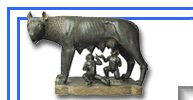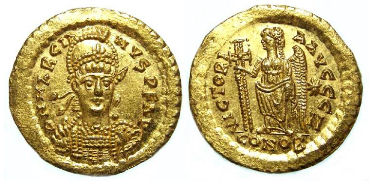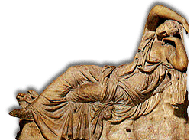THE TETRARCHY OF DIOCLETIAN
DIOCLETIAN, AD 284-305
Diocletian was proclaimed Emperor by his troops late in
AD 284, following the murder of Numerian. Carinus held power in Rome,
but was soon defeated by Diocletian who become sole Emperor in mid-285.
Realizing that the Empire was too vast for one man to control, and
proving himself an able administrator, he elevated Maximian to the rank
of Caesar (and later Augustus), with control over the Western Provinces.
In A.D. 293, Diocletian realized that two was still not
enough, so he devised a system based on two Augusti (himself and
Maximian) and two Caesars, to which rank he appointed Constantius I and
Galerius, thus forming the first tetrachy. If one then includes the
rebel Carausius, who was not officially recognized, but did effectively
control the province of Britannia, there was actually a total of five
men in power.
The system worked well while Diocletian was in control,
but upon his abdication things got very complicated, resulting in a
very interesting series of coins. It is not within the current scope of
this web site to go into detail about the power struggle that followed,
but you can find a good summary of it in ROMAN COINS AND THEIR
VALUES by David Sear.
CARAUSIUS, AD 287-293
As a general under Maximianus, Carausius was given the
task of clearing the sea of Frankish and Saxon pirates. He soon
rebelled and declared himself Emperor while taking control of Britannia
and part of Gaul. He appears to have been an able general, surviving
several attacks by Maximianus, but in AD 293 lost his possessions in
Gaul and was soon after murdered by his chief minister, Allectus.
MAXIMIANUS, 1st Reign AD 286-305, 2nd Reign 306-308
Many of the coins of Maximianus and Galerius are very
similar. Both were named Maximianus, and the portraits are very
similar, so there is often confusion in telling them apart. All issue
of Maximianus as "Caesar" are of Galerius, as are all issues that
include "GAL" in the inscription (although Maximinus II also uses
"GAL". For issues as "Augustus" without "GAL", one must pay careful
attention to the exact inscriptions to determine who is who.
GALERIA VALERIUS, wife of Galerius
Galeria Valeria was the daughter of Diocletian and
second wife of Galerius.
CONSTANTIUS I, AD 305-306
MAXIMINUS II, AD 309-313
MAXENTIUS, AD 306-312
LICINIUS I, AD 308-324
CONSTANTINE THE GREAT, AD 307-337
Constantine the Great was elevated to the rank of Caesar
in AD 306 and then Augustus in AD 307 as part of the tetrarchy
established by Diocletian. The tetrarchy continued to function (in a
manner of speaking) with two Augusti and up to three Caesars until AD
324 when Constantine defeated Licinius, leaving himself as Augustus
with this three sons, Crispus, Constantine II and Constantius II
holding the rank of Caesar.
Through much intrigue and murder, the family of
Constantine held the reins of power until Julian II (nephew of
Constantine) was killed in battle against the Sassanians in AD 363.
The house of Constantine was briefly restored in
September of AD 365 when Procopius, a relative of Julian II, led a
revolt against Valens of the house of Valentinian. He held
Constantinople for eight months until defeated and killed by Valens in
May of AD 366.
The denominations of the bronze coinage of this period
are not fully understood. For ease of classification, they will be
referred to by the letters "Æ" followed by the size rating as follows:
Æ 1 = more than 25 mm.
Æ 2 = 21 mm to 25 mm.
Æ 3 = 17 mm to 20 mm.
Æ 4 = less than 17 mm.
HELENA, mother of Constantine the Great
CONSTANTIUS II, AD 337-361
In AD 350, the general Magnentius rebelled against the
family of Constantine and proclaimed himself Augustus. Shortly
thereafter, Constans died and Magnentius' rule was accepted throughout
the Western Provinces. In AD 351 he granted the title Caesar to his
brother Decentius.
To counter this threat, the general Vetranio was raised
to the rank of Augustus (by Constantius) and given the job of keeping
Magnentius at bay while Constantius II was looking after affairs in the
East. In AD 351, Constantius II arrived and defeated Magnentius, at
which time Vetranio abdicated and was rewarded with an estate where he
lived out his life in peace (unusual for anyone ever who held the title
of Augustus).
JOVIAN, AD 363-364
On the death of Julian II, the army proclaimed the
general Jovian to be Augustus. He showed little promise as an emperor
and, while on his way to Constantinople, died of carbon-monoxide
poisoning caused by a brazier of charcoal left in his bed-chamber (this
may or may not have been an accident).
Valentinian I was proclaimed Emperor in AD 364, filling
the void left by the death of Jovian. As one man could not rule such a
vast Empire, he immediately raised his brother Valens to the rank of
Augustus with control of the East.
Gratian, the seven-year-old son of Valentinian, was
raised to Augustus in AD 367. When Valentinian died in AD 375, Gratian
found himself ruler of the Western Empire at the age 15, with Valens
still ruler of the East. Gratian immediately granted the title Augustus
to his four-year-old half-brother Valentinian II. In AD 378 Valens was
killed by the Visigoths who took control of the East and being unable
to rule alone Gratian was forced to grant the rank of Augustus to
Theodosius, who proved very able and quickly regained control of the
Eastern Provinces.
VALENTINIAN II, AD 375-392
In AD 383, Gratian was killed by the usurper Magnus
Maximus, who took control of the far West leaving the young Valentinian
II with only Italy under his control. Theodosius I, in charge of the
East, took the opportunity to raise his son Arcadius to the rank of
Augustus. Theodosius then turned his attention west and defeated Magnus
Maximus in AD 388. In AD 392 the murder of Valentinian II brought the
House of Valentinian to a close, leaving the House of Theodosius firmly
in power.
Theodosius came to power in AD 379, his son Arcadius in
AD 383, a second son Honorius in AD 393. Theodosius I died in AD 395.
In AD 402 Theodosius II (son of Arcadius) was given the rank of
Augustus, although his sister Pulcheria may have been the real power.
The history of this dynasty then becomes complex as
marriage ties become more important than bloodlines. Constantius III
was Augustus briefly in AD 421 following his marriage to Galla
Placidia, the half-sister of Honorius and their son, Valentinian III,
became Augustus in AD 425. In AD 450, Pulcheria married Marcian, who
was then proclaimed Emperor.
In AD 455 Petronius Maximus was proclaimed Emperor when
he married Licinia Eudoxia, daughter of Theodosius II, after murdering
her husband Valentinian III. The house of Theodosius came to an end 70
days later when Petronius was killed by a mob panic-stricken by the
approach of the Vandalic fleet out of Carthage.
|








